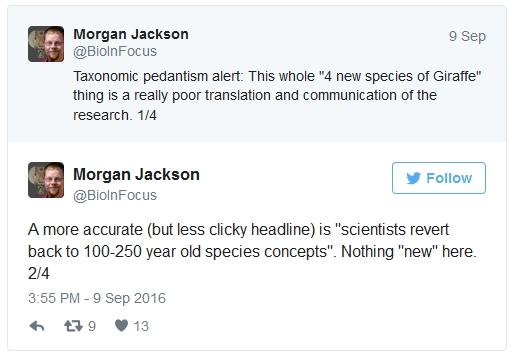Giraffes Get Caught Up in the Great Genetics Nerd Fight

You probably think you know giraffes. They’re those tall, tan and long-necked dudes with a fondness for acacia trees, grubbing leaves and roaming the savannah.
Well, not so fast.
A study in the journal Current Biology recently suggested that Giraffa camelopardalis, previously considered one species with nine subspecies, are actually four separate species: the northern giraffe, the southern giraffe, the reticulated giraffe, and the Masai giraffe. “We’re proposing that they’re genetically different,” says Julian Fennessy, the lead author of the study and the co-director of the Giraffe Conservation Foundation based in Namibia.
The distinction highlights just how disruptive genetic analysis has been to biological classification. Scientists have always been in conflict over what defines a species, and DNA is a great tool to understand the nitty-gritty differences between animals—it can be a lot more impartial than a scientists’ tabulation of physical characteristics like spots and antlers. But as always, that genetic data is subject to interpretation. And the new era of genetically-informed taxonomy is inciting debate about the best way to use this information.
The newly proposed giraffe taxonomy is based on genetic samples Fennessy gathered from all over Africa. His team spent more than five years using biopsy darts to extract samples of giraffe tissue. Then they sent the specimens to Axel Janke, a researcher at Goethe University in Frankfurt, Germany, who sequenced and analyzed DNA from several separate regions of the giraffe genome (sequencing the whole genome was too complicated). That analysis confirmed it’s been one to two million years since giraffe species diverged—showing how distinct the animals are from one another. Polar bears and brown bears, by contrast, forked away from each other more recently, approximately 400,000 years ago.
The news seems like a straightforward victory for the progress of knowledge—scientists deploy modern technology to solve the mysteries of the universe!—but some evolutionary biologists aren’t convinced. Morgan Jackson, a PhD candidate at the University of Guelph in Ontario, Canada, tweeted his skepticism:

“It’s not like the authors found a totally unrecognized and legitimately new species of giraffe that no one had ever noticed before,” says Jackson, who studies biodiversity and taxonomy—usually when it comes to flies. “We just split the populations up a little differently. It’s a little pedantic, but it’s also important people don’t think we’ve just blindly missed three different kinds of gigantic giraffes wandering around the savannah.”
He’s referring to a long-standing debate about how giraffes should be lumped together or split apart. We’ve had various taxonomic schemes that include more and less subspecies of giraffes,” says Klaus Koepfli, a research geneticist at the Smithsonian Conservation Biology Institute who co-published another study on giraffe genetics in 2007. “There were early naturalists who suggested different giraffe populations represented different species, and modernist taxonomists that have said they represent different subspecies.”
“Speciation is a process and a spectrum,” says Michelle Trautwein, an evolutionary biologist who specializes in molecular phylogenetics at the California Academy of Sciences. Early naturalists worked off isolated samples and visual observations, clumping certain characteristics together, and separating out others based on what they saw. Biomarkers that are important to one taxonomist might not be so important to the other: One might differentiate between Species A and Species B based on number of ossicones (those giraffe antler things), and another might focus on leg length or coat pattern to split them up.
In the last few decades, however, taxonomists have stopped making their classification decisions primarily based on species’ morphology, behavior, and geographic ranges. Now they have access to another character set—DNA. But genetic analysis can make things more complicated, too. It can back up classifications we already have, yes, but it can also split species in ways we didn’t expect or lump them back together.
Genetic analysis can compliment traditional taxonomic techniques, but it doesn’t always confirm it. “Genetic methods provide another lens through which to view species,” says Trautwein. “They can reveal more diversity than the eye can see—by uncovering cryptic species that may look identical to the outside observer, and they can also sink species that may look different, but lack genetic differentiation.”
And just like taxonomists have debated over which physical characteristics warrant a new species designation, they’re conflicted over how much genetic variation you need to prove differentiation. “Some people advocate for a certain percentage difference in one gene, say 2 percent, and others are only satisfied with entire genomes,” Jackson says. The new proposed giraffe taxonomy is one group’s interpretation of the genetic record, but it’s not the final say. DNA analysis is a tool—not an oracle.
